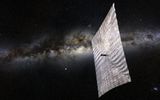
| Added | Mon, 10/10/2016 |
| Sources | |
| Феномены | |
| Version type |
A solar sail is a device that uses the pressure of sunlight on the mirror surface for propulsion of the spacecraft.
It is visible to the naked eye in many parts of the world as a dim star, which is a few minutes glides through the sky. It can reach a value of 4.8 brightness, but can flare up and brighter when the Sun makes a glare on its surface at a certain angle.
He first appeared on the pages of works of science fiction (e.g. the novel "the strange adventures of a Russian scientist" by Georges Le Faure and Henri de Countess of an expedition to Venus, mentioned a huge parabolic mirror that is used for movement in space.
The first in the history of the real aircraft on a solar sail invented by a Soviet engineer Fridrikh Tsander in 1924 (he filed with the Commission on inventions of the application, but experts rejected it, calling too fantastic). In the West, this design was offered to scientist-astronomer Carl Sagan in 1976.
In 1974, as part of the launch of the American automatic interplanetary station Mariner-10, as a solar sail made of solar panel. This design allowed us to adjust the location of the ship in space.
In 1989, the jubilee Commission of the U.S. Congress in honor of the 500th anniversary of the discovery of America was a competition. His idea was to launch into orbit several solar sailing ships, developed in different countries, and the conduct of yacht racing to Mars. All the way planned to go for 500 days. Their applications for participation in competition are USA, Canada, UK, Italy, China, Japan and the Soviet Union. The launch was to take place in 1992.
The first deployment of a solar sail in space was produced on the Russian ship "Progress M-15" February 24, 1993, in the framework of the project "Znamya-2". The recent launch - June 7, 2015 at 22:51 on the second attempt managed to open the solar sail experimental satellite, Lightsail, which was launched on 20 may.
Translated by «Yandex.Translator»
Log in or register to post comments






